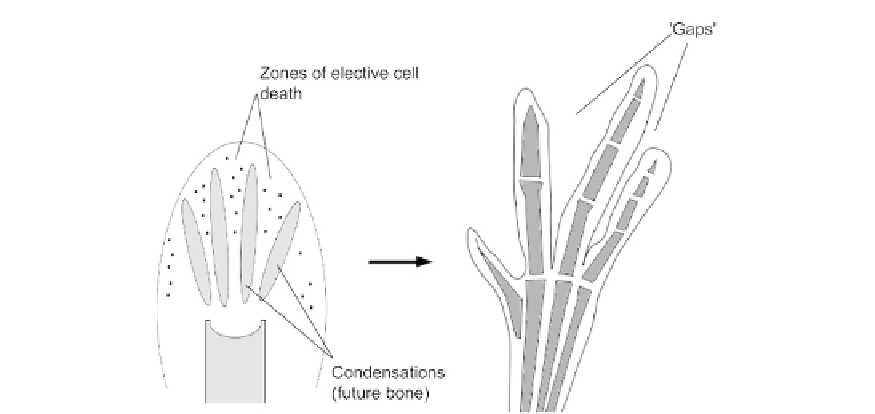Biology Reference
In-Depth Information
FIGURE 24.2
The role of elective cell death in separation of the digits. Mesenchymal condensates that lay down
the cartilaginous models for the bones of fingers and toes develop inside the paddle-shaped end of the limb bud.
Zones of elective cell death, shown as dots, then eliminate tissue between the digits and thus separate them. This
finger is sketched from micrographs in an article by V. Zuzarte-Luis and J.M. Hurle.
17
a paddle-like palm but rather form inside the paddle itself (
Figure 24.2
). Once the condensa-
tions that herald each phalanx of a digit have formed, there is a large amount of elective cell
death in the zones between the digits, the dead cells being cleared up by macrophages.
14
This
cell death appears to take place by both caspase-dependent and caspase-independent
mechanisms.
15
e
17
Elective cell death in the interdigital zones seems to be induced specifically by proteins
of the BMP family, which are involved with the patterning of the limb. This specific induc-
tion makes this type of elective cell death distinct from that seen in the population
balancing and tidying-up applications described below, for in those applications cells
die because they are not persuaded to live, whereas in the interdigital zone they die
because they are told to. BMP2, BMP4 and BMP7 all induce massive elective cell death
in the interdigital zone, although they encourage growth and differentiation in nearby
cells that are already committed to forming cartilage.
18
e
21
The importance of elective cell
death in separating the digits of the hands and feet is emphasized by the mouse hammertoe
mutant, in which interdigital death does not take place and the toes fail to separate prop-
erly.
14
The development of webbed feet by this mutant can be prevented by inducing elec-
tive cell death in the interdigital zone through treatment of the embryos with exogenous
retinoic acid, which happens to induce elective cell death in this system,
22
probably via
BMPs.
23
An apparently similar pattern of elective cell death is also required to separate
the paired bones in the lower arm (radius/ulna) and in the lower leg (tibia/fibula).
24,25
In the chick mutation talpid3, this zone of elective cell death fails and the paired bones
fuse.
26
In birds in which digits are fully separated in the mature foot, such as chickens, elec-
tive cell death extends all the way down the digit. In webbed-footed species, such as

